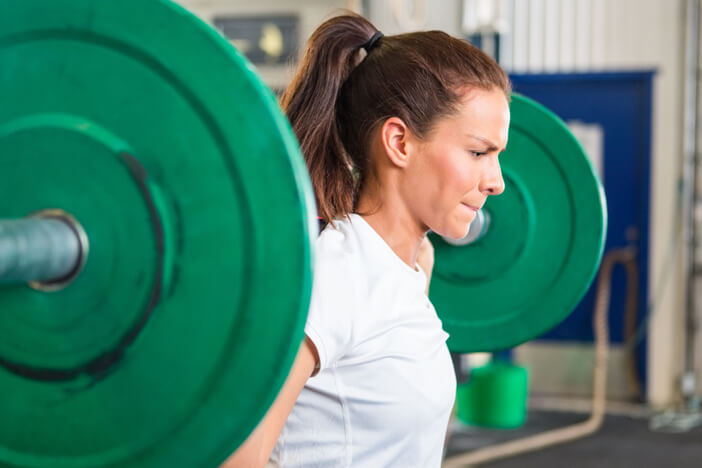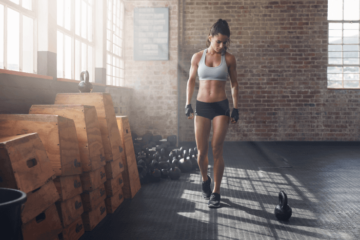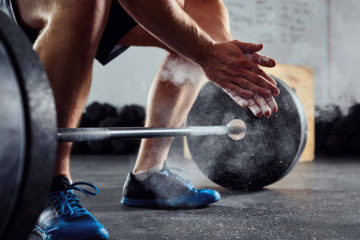Barbell squats - a full-body exercise

Squats: Targeted muscle groups
Squats are one of the fundamental weight training exercises and accordingly require a large number of muscles simultaneously. Squats are therefore particularly strenuous and challenging.
Primary muscle groups used:
- Front thigh muscles (quadriceps)
- Hip extensor, especially gluteus maximus (large gluteus muscle)
- Lower back muscles (especially back extensor)
Secondary muscle groups used:
- Abdominal muscles
- Hip adductors and abductors
- Calves
- Posterior thigh muscles (leg biceps, ischiocrural muscles)
- Shoulder muscles (retroversion and retraction)
Squats are a fundamental exercise because they involve a large number of muscle groups, inparticular the legs and the bottom. The exercise is therefore a great inclusion in your leg training and bum training plan.
Correct execution of squats

Correct execution is essential to get the most out of this exercise and to minimize the risk of injury. It is also important to choose the right shoes for squats. To ensure that you have a firm footing, your soles should not contain too much spring. Weightlifting or CrossFit shoes are ideal for squats because they have a slightly raised heel, which provides increased stability. If you don’t want to buy such shoes especially for squats, you can also do the exercise in firm, flat shoes, such as vans, or even barefoot. Only do this if you have previous experience with strength training and squats. Otherwise try it first by putting a small weight plate under each heel of your flat shoes.
Preparation
The barbell bar should be in front of you at chest height. It should not be too high in the power rack, because if you have to tiptoe to take the barbell out of the rack, you can easily slip and hurt yourself. Then grab the barbell so that your hands are wider than the width of your shoulders. A narrower grip will give you more stability but the grip width must be equally narrow/wide on both sides. Your wrists should be in a straight line with your forearms and not be bent. For the “Low Bar” squat, the bar is located on your back on the bone fossa of the shoulder blade. For the “High Bar” squat, the bar is on the upper trapezius. For the low bar squat your thumbs should lie on the bar but not grasp it. This way your hands do not absorb all the weight and you minimize the risk of injury. For the high bar squat your thumbs enclose the bar. Your hands should remain in the same position during the whole exercise and the bar should be located just above the middle of your foot when viewed from the side. Your stance should be stable and at least shoulder-width apart. Beginners with a lack of hip mobility often benefit from a slightly wider stance. Your feet should point outwards at an angle of about 15-30° with your knees pointing in the same direction as the tips of your feet for the entire exercise.
Note: do not put a cushion under the bar. Cushions make the bar less stable and liable to slip. Besides, a cushion should not be necessary, because the bar will not hurt your back if you are doing the exercise correctly.
Getting started
Once you have positioned yourself correctly, you can take the barbell out of the rack. To do this, straighten your legs and extend them. Holding the barbell, take one or two safe, controlled steps backwards, so that you can move freely. You are now standing in the same position you were in before you had the barbell. Avoid several small steps, because you can easily lose your balance.
High bar squat: keep your lower back as straight as possible and your elbows perpendicular under the barbell. Try to press your elbows under the barbell, while at the same time pulling your shoulder blades together and lifting your chest to build up tension in your upper body. Your head should form a line with your torso. This means that it forms an extension of your back – you are not looking at the floor, mirror or side. It is best to fix your gaze on a point about 2-3 meters in front of you during the whole movement. This prevents unnecessary injuries, especially to your cervical spine.
Low bar squat (power squat): this has some disadvantages compared to the high bar version and is therefore only used in specific training plans or powerlifting training. Here the elbows are pulled backwards and upwards to secure the bar and due to the less favourable position of the bar, the upper body is in a slight forward bend when the back is straight.
The Breathing
Correct breathing is essential to get the most out of this exercise. In addition, correct breathing stabilizes you and helps you to perform the squats correctly. Before you start to squat down, take a deep breath and hold it until you are back up. The air in your lungs will give you more stability in your stomach. This is the so-called “Valsalver Maneuver”: you take a breath at the top, hold it during the squat and rise and then breathe out and in again at the top. It is also possible to inhale during the downward movement and then hold it during the upward movement. This will especially help those who have a problem with a slow, controlled downward movement.
The downward movement
Now it’s time to create tension in your body. Imagine someone is hitting you in the pit of your stomach and you can only repel the blow by tensing your abdominal muscles. Maintain this abdominal tension during every single repetition. Push your hips backwards while your knees bend and push forward and outwards. For this, imagine that you are sitting on a small stool or the toilet. But only go as low as you can while keeping your back straight! Ideally, you should be able to break the parallel position with your back straight. This is where your bottom is below knee height at the deepest part of the squat. In the high bar squat you have reached your full range of motion when your back thigh completely covers your calf while the upper body is upright and your heels are firmly on the ground. In any case, you should distribute your weight evenly between the forefoot and heel throughout the exercise. For the low bar squat, the lowest position is reached when your thighs are parallel to the ground.
The upward movement
From the lowest point of the squat you go directly up again. To do this, push your knees outwards, keep your chest up and press your feet into the ground. The barbell should be in a vertical line above your metatarsus and your upper body should remain straight the whole time. It is best to pause briefly at the top between repetitions. To do this, push your knees forward together with your hips and breathe out so that the weight rests securely on your frame (“Lock Out”). Now focus on your next repetition and take a deep breath. After you have completed your final repetition, put the barbell back into the rack in a controlled manner. Make sure that the barbell is securely in the holder by checking left and right.
Recommended weight for squats

Squats and deadlifts are the free weight exercises where one can lift the most weight. Due to the complex execution, it is nevertheless particularly important in squats to first master the correct technique in order to avoid injuries. As a beginner you can practice with a broomstick or with just the barbell without any additional weight. Once your technique is correct, you can then begin to slowly increase the weight – the correct execution should still be the main focus for advanced athletes.
Equipment for Squats
- Barbell (preferably an Olympia barbell of 220 cm length)
- If necessary weight discs
- Power Rack or other barbell mount
Variations of Squats

There are countless variations of squats with and without weights.
High Bar and Low Bar Squats
The classic backsquats can be divided into High Bar and Low Bar squats. In the Low Bar squat, the bar is positioned about 2.5 to 5 cm lower on the back than in the High Bar squat. The low bar version involves the hip extensors more and the leg extensors less than in the high bar version, which is a more complete exercise due to a shifted center of gravity and a smaller range of motion. In addition, due to the stronger forward extension in the low bar position, the lower back is stressed a little more than in the high bar position, where the posture is more upright. On the other hand, the high bar version requires greater mobility in the ankle joints and the knees. Note, you will acquire this mobility by repeating the exercise. Which option you find easier comes down to your flexibility and your individual anatomy. The relationship between your upper and lower body is a deciding factor: if you have a short upper body and long legs you will probably find it difficult to keep your upper body vertical and the low bar might be a better alternative. However, your goal should be to be able to perform a technically correct High Bar squat, as this is associated with a good strength ratio of the muscles in your body and adequate mobility. There is no body type for which this goal is impossible.
Goblet Squat
The goblet squat can help you to learn the movement sequence of the classic backsquats. In a goblet squat you hold a dumbbell or kettlebell in front of your body at chest height and use this weight to perform the bending movement. Because it is easier to keep your balance like this than with the weight behind your head, you can bend deeper. Many muscle groups in the legs and torso, which are used to full capacity in other squat variations with heavy stabilisation work, are subjected to much less strain, so that you can target certain muscle groups more precisely by making slight adjustments to your movements. Furthermore, you can simply drop the barbell if you lose your balance.
Front Squat
In front squats, the barbell bar is not held behind your head but in front of you, on your shoulder and chest muscles. The load is therefore not focussed on your buttock muscles, but instead the quadriceps. The challenge here is to have a correct grip. The difference in the load focus in comparison to the classic squat means that you will have to reduce the weight you use significantly, because firstly the large gluteus is less involved and secondly your torso muscles have to do a lot more stabilising work by shifting the centre of gravity forward.
Typical mistakes with squats

- A rounded back: this is where your back is no longer in a neutral position for the squat, but rounds up in the area of the lumbar spine. The pelvis tilts forward and the coccyx is below the middle of the body. The problem with this is that your lumbar spine has to withstand extreme stress. If you train with a rounded back for a long time, you will sooner or later suffer the consequences. Causes of a rounded back include tight hamstrings or a lack of mobility in the ankle joint.
- The shrimp: this happens in the upward movement of the squat if you overstretch your back and end up with a hollow back. The consequence is back pain after performing the squats. Causes of the shrimp can be, a lack of core strength or incorrect breathing technique.
- The “good morning”: this is where your bum comes up faster than your chest. These two things should actually happen simultaneously in one fluid movement. This mistake usually lies in a too weak musculature of the upper back and / or the leg extenders. This weakness is compensated by changing the position of the back and hip extensors. Solution: use less weight and train the weaknesses specifically.
- The knees collapse inwards: with squats your knees should point in the direction of your toes for the whole movement to avoid knee pain and permanently damaging your knees. Knees falling inwards, especially in the upward movement, indicate a strength deficit of the vastus medialis and the hip abductors. Use a lighter weight for your squats and additionally train the weak muscles.
- Bent wrists: pain in your wrists when bending your knees often indicates that you are bending your wrists during the exercise. Wrists should be straight throughout the exercise and should be an extension of the forearms. The problem causing this is usually insufficient shoulder mobility. Train the retraction and exorotation of your shoulders.
In which training schedules do squats appear?
Find out how to optimally integrate squats into your training and which other exercises you should supplement your training with in our pages about leg training and bum training.
Frequently Asked Questions
Squats with additional weight should be done about twice a week. Make sure that you allow the exerted muscle groups enough time to regenerate between the two training sessions.
Squats and deadlifts are the free weight exercises where one can lift the most weight. Due to the complex execution, it is nevertheless particularly important in squats to first master the correct technique in order to avoid injuries. As a beginner you can practice with a broomstick or with just the barbell without any additional weight. Once your technique is correct, you can then begin to slowly increase the weight – the correct execution should still be the main focus for advanced athletes.
Pay particular attention to maintaining a straight back, correct breathing technique and a controlled execution of the squats. It is a myth that knees should not protrude over the toes during the exercise!



